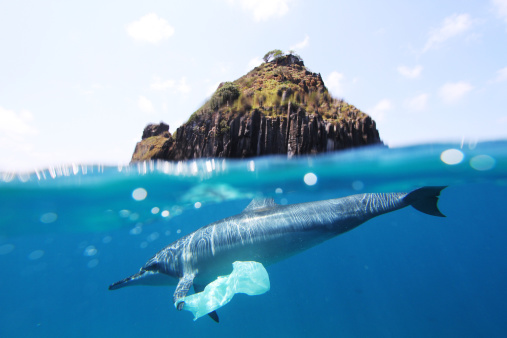
This dolphin might look like it’s heading home from the grocery store, but what it’s really heading to is an early grave.
An April 4th National Geographic Daily News article came out with this as its title: Plane Search Shows World’s Oceans Are Full of Trash.
Two thoughts went through my head when I saw this:
1) This is the news outlet for National Geographic — a well-respected publication that has been around for well over 100 years. They do extensive scientific research and they write informative, truthful articles.
2) Crap.
The content of the article delves into how, during the search for Malaysia Airlines Flight 370, possible spotted debris from the plane turned out to be mass amounts of garbage. Specifically, plastic. Things like plastic bags and discarded fishing equipment that are being ingested by marine life to a detrimental effect. The article further points out that this has been going on for quite a while, though under the radar of most beach-going tanners. It suggests that the tragedy of Malaysia Airlines Flight 370 has brought the issue to the world’s attention. Every day that the search continues, more marine debris, none of it from the plane, is being found.
There are five major garbage patches throughout the planet. There is no mass island of trash, as the name might suggest, but there is still a huge problem. These patches are mass amounts of garbage concentrated in gyres (any large system of rotating ocean currents) that are constantly moving and carrying the garbage across our oceans. The Great Pacific Garbage Patch is the largest garbage patch, with 100,000 to one million large wood objects, including things like telephone poles and timber and beams from houses, floating in an area the size of Texas between California and Hawaii. Since the area is so vast and the gyres are constantly moving the waste, in some places and on some days you may see nothing. Always present, but not always visible, are broken-down bits of plastic that sea life are ingesting and dying from. The debris is smothering and crushing sensitive ecosystems like coral reef systems and the ones that bottom-dwelling species live in, at the same time entangling, drowning, choking, and starving other sea creatures.
Wanting to learn more, I followed a link in the article to The National Oceanic and Atmospheric Administration’s Marine Debris website. Being a visual learner, their one-page posters about marine debris and garbage patches helped me get straight to the facts come to the realization that the problem is huge and the solution is not simple or easy. The debris may, in many cases, be impossible to clean-up without further harming marine life.
There are suggested ways to help — minimizing your personal waste, recycling, reusing, and reducing — which are things most of us learned in grade school. As an adult, what I take away from this article and the information I’ve learned is that we have created a massive problem that we will likely never fix, as horrible and depressing as that might sound. An “out of sight, out of mind” approach seems to be the one most of the world has adopted, but that’s an excuse the world can no longer use, not if doesn’t want to look blatantly heartless. The tragedy of Malaysia Airline Flight 370 has brought another one to light : the world’s oceans, and its inhabitants, are being changed and destroyed by our waste.
5 Gyres is an organization whose mission is to “conduct research and communicate about the global impact of plastic pollution in the world’s oceans and employ strategies to eliminate the accumulation of plastic pollution in the 5 subtropical gyres.” Their website is interactive and kid-friendly if you are thinking about educating your children about this issue because, let’s face it, they’re most likely going to have to deal with it.










-300x169.jpg)





